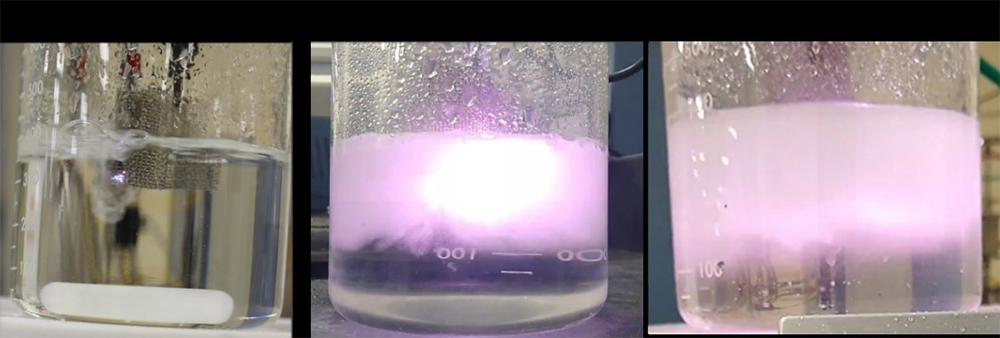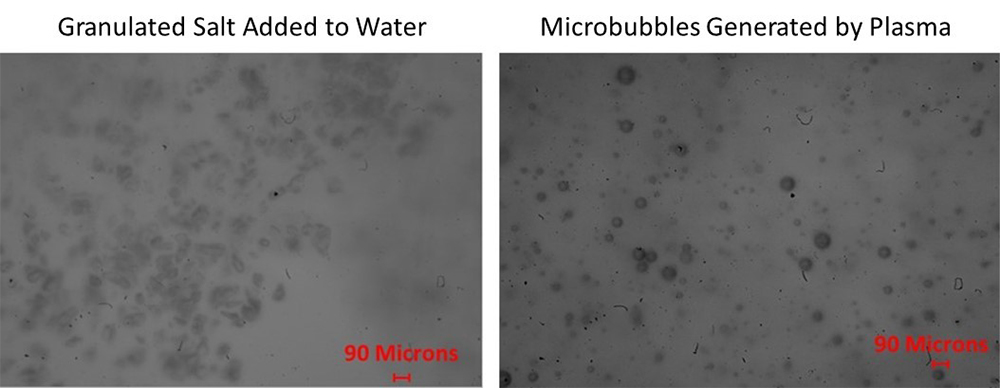Background
Desalination using reverse osmosis (RO) is the most prevalent and cost-effective technique to convert seawater into freshwater. However, RO desalination becomes less cost effective as the total dissolved solids (TDS) in the feed water increase beyond 40,000 ppm due to accelerated membrane degradation and increased osmotic pressure required to push the water through the membranes. For reference, the TDS in the Gulf of Mexico is 35,000 ppm (~3.5 wt%), while the TDS of water brines produced from the oil and gas industry can exceed 200,000 ppm. Such high-salinity brines are of significant environmental concern for marine ecosystems, groundwater contamination, and wastewater treatment plants. Thermal distillation processes can address high-salinity brines; however, these processes are also prohibitively expensive due to their high-energy consumption. Plasma-based salt precipitation has been reported by other research groups, and the objective of this research was to experimentally investigate whether a process could be developed using SwRI’s High-Power Impulse Plasma Source (HiPIPS) to remove dissolved salts in brines as a pre-treatment for conventional water desalination technology.
Approach
A variety of tests were conducted in this program to characterize if HiPIPS plasma could be utilized to directly precipitate salts that could be extracted from the solution. These tests can be divided into three main areas: batch testing in a beaker (shown in Figure 1 below), filtration and extraction of samples, and high-speed imaging. Batch testing in a beaker investigated immersing the plasma electrodes in water solutions and studying variables such as: plasma voltage, salt concentration, stirred versus stagnant solutions and solution temperature. Filtration tests were conducted on plasma-treated solutions in static and flowing conditions to determine if solids could be extracted using filters with pore sizes as small as half a micron. Lastly, high-speed imaging of the plasma reaction was executed to investigate the geometry of the particles produced by the process.

Figure 1: Comparison of distilled water to salt solutions undergoing plasma treatment: (a) Distilled water, (b) 10 wt% salt solution, (c) 25 wt% salt solution. While the cloudiness between images (b) and (c) may not appear different, the obscuration of the plasm-generated light in (c) demonstrates higher reactivity between the plasma and the solution.
Accomplishments
A variety of tests were performed to understand SwRI’s HiPIPS plasma ability to precipitate salts in solution but attempts to filter out or extract any potential salt precipitates were unsuccessful. The high-speed imaging showed that most of the cloudiness that was initiated by the plasma is from dissociated gas forming microbubbles rather than salt precipitates, as shown in Figure 2. One possible explanation is that the salt increases the conductivity of the solution and hence increases the intensity and range of the plasma’s electric field and its ability to dissociate the water molecules into gas bubbles via water electrolysis, similar to an experiment reported by other researchers. Although the original intent of this work (salt precipitation) was not demonstrated, this research initiative has created a more thorough understanding of plasma-liquid systems, which has applications in water treatments, hydrogen production, and environmentally friendly agriculture practices. The researchers are currently seeking funding opportunities to advance plasma-liquid technology in these areas.

Figure 2: Images comparing granulated salt with microbubbles: Salt crystals are non-spherical as shown in the image on the left from the high-speed camera video of sieved, granulated salt that was added to water. Microbubbles are spherical due to surface tension during plasma treatment, as shown in the image on the right.
